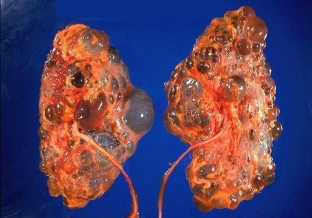A cavity formation in a parenchymal organ called a cyst may also be present in the kidneys, impairing their function. Congenital cystic transformation of the kidney tissue is called polycystic kidney disease. This happens as a result of a malformation of the embryonic development of the renal tubules and is manifested by the formation of small multiple cysts in the renal parenchyma. Polycystic kidney disease is always bilateral. The size of the cysts may vary, the cyst may have contents of different consistency and color. As the cysts grow progressively, they can lead to kidney failure.
What are the forms of polycystic kidney disease?
Polycystic disease in most cases is not limited to damage to the kidney tissue. As a rule, cysts are detected in the pancreas, liver, spleen, seminal vesicles, lungs.
In urology, polycystic kidney disease is isolated, which is transmitted in an autosomal dominant manner, is detected in older children and adults, and here polycystic kidney disease with autosomal – recessive inheritance is more common in newborns. The mechanism of development of polycystic disease, read further on estet-portal.com. Cysts can be closed or open. Closed cysts are closed cavities, they do not communicate with the lumen of the tubules and do not provide a excretion function. Cysts of this type are found in newborns with polycystic kidney disease and have a poor prognosis.
Open type cysts are diverticuloid extensions of the tubules that communicate with the pelvis and calyces.
Polycystic kidney disease with an open type of cysts is not detected for a long time, since the functioning of the kidneys is not disturbed for a long time, therefore such polycystic disease is detected in older children and adults.
Causes and mechanism of development of polycystic kidney disease
The main cause of polycystic kidney disease is the transfer of mutant genes from both parents, which cause a defect in the structure of the kidney tissue. If polycystic disease occurs in a child whose parents are healthy, a new mutation in the germ cell of one of the parents is expected.
In the mechanism of development of polycystic kidney disease, a violation of the fusion of secretory and excretory structures of the nephron at the stage of formation of the secondary kidney was revealed. These changes make it difficult to excrete primary urine, contribute to an increase in pressure in the renal tubules, which is accompanied by deformation of their lumen and the formation of cystically enlarged cavities.
Clinical manifestations and stages of polycystic kidney disease
Polycystic kidney disease in a newborn has a very unfavorable course and ends with the early death of the child from uremia. In adults, polycystic kidney disease proceeds more slowly and goes through 3 stages: compensation, subcompensation and decompensation.
Clinical manifestations of polycystic kidney disease at different stages of the process:
- Compensation Stage – there may be pain in the abdomen, a feeling of pressure in the lower back. There is dysuria, which is caused by stretching of the kidneys. Patients complain of increased fatigue, headaches. Sometimes there is hematuria.
- Subcompensation stage – accompanied by symptoms of renal failure. Nausea, dry mouth, migraine attacks, thirst, persistent arterial hypertension appear. Kidney function is characterized by polyuria with isostenuria, cylindruria and erythrocyturia.
- Stage of decompensation – accompanied by chronic uremia. Contributes to the progression of arterial hypertension, trauma, surgery, bleeding and pregnancy.

Possible complications of polycystic kidney disease
The subcompensated stage may be complicated by the development of pyelonephritis. Cysts may fester, which is manifested by fever and chills.
In the stage of decompensation, polycystic kidney disease can be complicated by the addition of a secondary infection. In this case, the patient's condition deteriorates sharply until death.
Polycystic kidney disease is accompanied by a persistent increase in blood pressure, which contributes to the development of left ventricular hypertrophy, heart failure and mitral valve prolapse. It is also possible to develop hemorrhagic stroke and cerebral aneurysms. Thus, a patient with polycystic kidney disease is at risk of developing kidney failure and other pathological conditions.







Add a comment